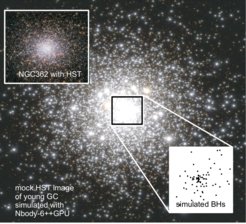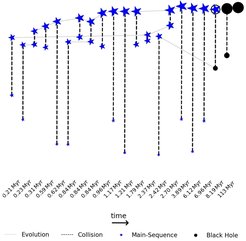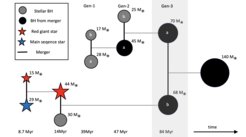The formation of intermediate mass black holes in young massive star clusters
Intermediate mass black holes (IMBH) should be linking observed stellar black holes and supermassive black holes, but their formation mechanisms are still debated. Young and dense massive star clusters are promising environments for the formation of such black holes through collisions. An international team lead by MPA researchers has presented novel realistic simulations of star clusters, where these missing links form by rapid collisions of stars and black holes. The study also predicts an IMBH formation channel by the merging of black holes in a mass regime, which is excluded by stellar evolution models. In this “mass gap” a black hole merger has indeed been observed recently by the LIGO/Virgo gravitational wave collaboration.

Convincing theoretical and observational evidence points to the existence of stellar black holes with masses below about 60 solar masses. These are the end products of massive stars, evolving over several million years. On cosmic scales this is a short life. There is also direct evidence for the existence of supermassive black holes with a million solar masses and more. The most famous one lurks in the center of our Milky Way, whose discovery was honored with the Physics Nobel Prize in 2020. Until recently, however, there was no direct evidence for the existence of intermediate mass black holes (IMBHs) with masses in between those two ranges and several speculations about their formation mechanisms were presented.
Theoretically, young, massive, and dense star clusters are promising environments for the formation of IMBHs. These clusters are gravitationally bound groups of young stars and their early black hole remnants. In the early phase of star cluster evolution, their central stellar densities can reach a million times the average stellar density in our galactic neighborhood. Therefore, direct collisions of massive stars and black holes and even mergers of black holes, which are driven by the emission of gravitational waves, are relatively common. Such collisions can result in the formation of IMBHs.

Fig. 2 Example for the formation of an IMBH in one of the simulations. In the first 8.19 million years (from left to right) after the beginning of the simulation many main sequence stars merge into a very massive star with 315 solar masses with is swallowed by a stellar mass black hole of 12 solar masses forming an IMBH. About 100 million years later, the IMBH merges with another stellar mass black hole of 22 solar masses.
An international team lead by MPA researchers has performed a series of realistic simulations of the early evolutionary phase of compact massive stars clusters to investigate the formation of IMBHs. The high-accuracy simulations have been performed with the GPU accelerated simulation software N-body6++GPU (2) at the Max-Planck-Computing and Data Facility in Garching and the JUWELS system at the Jülich Supercomputing Center. The simulations follow the stellar evolution and motion of each star in the clusters, including accurate orbits of single, binary and multiple systems as well as stellar collisions and mergers of black holes. The study demonstrates that IMBHs can form when a very massive star with up to 400 solar masses – formed by the rapid collision of several main sequence stars – is swallowed in a merger with a stellar mass black hole (Fig. 2).
In one of the 80 simulations with 110.000 stars each, a IMBH with 138 solar masses followed a special formation path. It formed in four generations of collisions with several stellar black holes. In the final merger two black holes with 68 and 70 solar masses form a IMBH with over 100 solar masses (Fig. 3). Black holes in this mass regime are not predicted by normal stellar evolution models (so called “mass-gap”) and therefore must have formed by other processes such as the collisions in this study.

Fig. 3 Simulated formation path of a “mass gap” black hole merger of two black holes with 70 and 68 solar masses. The more massive BH (top) grows by two preceding BH mergers. The lower mass BH (bottom) builds up in a stellar collision of a red giant with a main sequence star followed by the merger with a stellar mass BH. The masses of the components (in solar masses) are indicated at the respective times of the merger (black horizontal lines) after the start of the simulation.
Less than two weeks after the submission of this theoretical study the LIGO/Virgo gravitational wave collaboration reported the discovery of the merger of two black holes (GW190521) in this “mass gap” with masses of 66 and 85 solar masses. This was the first direct detection of an IMBH with a mass of 142 solar masses formed in a black hole merger and the theoretical study indeed had predicted a possible formation path for such a gravitational wave event.














